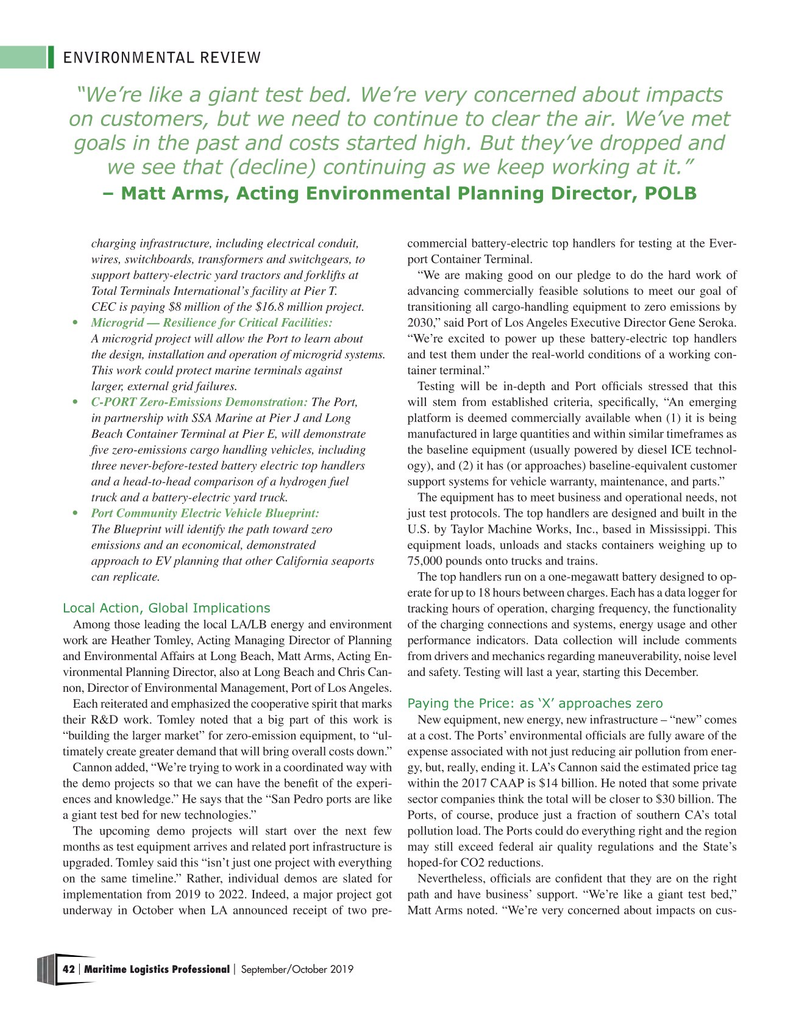
Page 42: of Maritime Logistics Professional Magazine (Sep/Oct 2019)
Energy Ports Oil-Gas-LNG
Read this page in Pdf, Flash or Html5 edition of Sep/Oct 2019 Maritime Logistics Professional Magazine
ENVIRONMENTAL REVIEW “We’re like a giant test bed. We’re very concerned about impacts on customers, but we need to continue to clear the air. We’ve met goals in the past and costs started high. But they’ve dropped and we see that (decline) continuing as we keep working at it.” – Matt Arms, Acting Environmental Planning Director, POLB c harging infrastructure, including electrical conduit, commercial battery-electric top handlers for testing at the Ever- wir es, switchboards, transformers and switchgears, to port Container Terminal.
support battery-electric yard tractors and forklifts at “We are making good on our pledge to do the hard work of T otal Terminals International’s facility at Pier T. advancing commercially feasible solutions to meet our goal of CEC is paying $8 million of the $16.8 million project. transitioning all cargo-handling equipment to zero emissions by • Microgrid — Resilience for Critical Facilities: 2030,” said Port of Los Angeles Executive Director Gene Seroka. A micr ogrid project will allow the Port to learn about “We’re excited to power up these battery-electric top handlers the design, installation and operation of microgrid systems. and test them under the real-world conditions of a working con- This work could protect marine terminals against tainer terminal.” lar ger, external grid failures. Testing will be in-depth and Port offcials stressed that this • C-PORT Zero-Emissions Demonstration: The Port, will stem from established criteria, specifcally, “An emerging in partnership with SSA Marine at Pier J and Long platform is deemed commercially available when (1) it is being Beac h Container Terminal at Pier E, will demonstrate manufactured in large quantities and within similar timeframes as fve zero-emissions cargo handling vehicles, including the baseline equipment (usually powered by diesel ICE technol- thr ee never-before-tested battery electric top handlers ogy), and (2) it has (or approaches) baseline-equivalent customer and a head-to-head comparison of a hydrogen fuel support systems for vehicle warranty, maintenance, and parts.” truc k and a battery-electric yard truck. The equipment has to meet business and operational needs, not • Port Community Electric Vehicle Blueprint: just test protocols. The top handlers are designed and built in the The Blueprint will identify the path toward zero U.S. by Taylor Machine Works, Inc., based in Mississippi. This emissions and an economical, demonstrated equipment loads, unloads and stacks containers weighing up to appr oach to EV planning that other California seaports 75,000 pounds onto trucks and trains.
can r eplicate. The top handlers run on a one-megawatt battery designed to op- erate for up to 18 hours between charges. Each has a data logger for
Local Action, Global Implications tracking hours of operation, charging frequency, the functionality
Among those leading the local LA/LB energy and environment of the charging connections and systems, energy usage and other work are Heather Tomley, Acting Managing Director of Planning performance indicators. Data collection will include comments and Environmental Affairs at Long Beach, Matt Arms, Acting En- from drivers and mechanics regarding maneuverability, noise level vironmental Planning Director, also at Long Beach and Chris Can- and safety. Testing will last a year, starting this December.
non, Director of Environmental Management, Port of Los Angeles.
Each reiterated and emphasized the cooperative spirit that marks Paying the Price: as ‘X’ approaches zero their R&D work. Tomley noted that a big part of this work is New equipment, new energy, new infrastructure – “new” comes “building the larger market” for zero-emission equipment, to “ul- at a cost. The Ports’ environmental offcials are fully aware of the timately create greater demand that will bring overall costs down.” expense associated with not just reducing air pollution from ener-
Cannon added, “We’re trying to work in a coordinated way with gy, but, really, ending it. LA’s Cannon said the estimated price tag the demo projects so that we can have the beneft of the experi- within the 2017 CAAP is $14 billion. He noted that some private ences and knowledge.” He says that the “San Pedro ports are like sector companies think the total will be closer to $30 billion. The a giant test bed for new technologies.” Ports, of course, produce just a fraction of southern CA’s total
The upcoming demo projects will start over the next few pollution load. The Ports could do everything right and the region months as test equipment arrives and related port infrastructure is may still exceed federal air quality regulations and the State’s upgraded. Tomley said this “isn’t just one project with everything hoped-for CO2 reductions. on the same timeline.” Rather, individual demos are slated for Nevertheless, offcials are confdent that they are on the right implementation from 2019 to 2022. Indeed, a major project got path and have business’ support. “We’re like a giant test bed,” underway in October when LA announced receipt of two pre- Matt Arms noted. “We’re very concerned about impacts on cus- 42 Maritime Logistics Professional September/October 2019 | |

 41
41

 43
43
